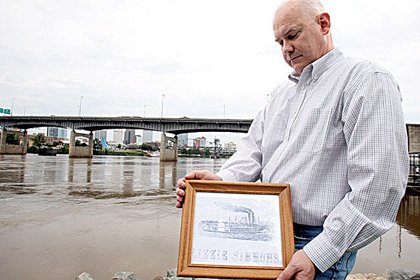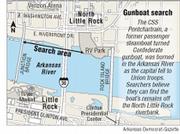LITTLE ROCK — William Stevens has played the part of a Confederate soldier during Civil War re-enactments. Now he's playing detective, hoping to find remains of a Confederate gunboat burned in the Arkansas River just before Little Rock fell to Union troops.
It's been 146 years since the CSS Pontchartrain was torched to prevent it being seized by the North. In the years since, the Arkansas River has changed, and the riverfront has been filled in. Still, Stevens hopes to find some remnants, possibly a bell or engine, of the steam-powered boat that started outas the Lizzie Simmons.
Like many century-old tales, the truth about what happened on Sept. 10, 1863, has been distorted. Some more recent legends say the gunboat went down on the White River in Arkansas County at the Civil War skirmish at St. Charles (it didn't - but men from the boat supposedly fought there) or that it sunk loaded with gold near an area of Pulaski County called Natural Steps.
The commissioner of state lands thought briefly in 2007 that the Pontchartrain could have been found during a channel study by the U.S. Corps of Engineers. The submerged vessel turned out to be a pontoon boat from the late 1800s to early 1900s, and searchers didn't find anything else sticking up from the bottom as they trolled along from the Interstate 30 bridge to Main Street.
But Stevens, a human resource specialist by day, thinks he has a good idea on the CSS Pontchartrain's present-day location: North Little Rock's riverbank somewhere between the Junction Bridge and the new RV Park. No one's been able to pinpoint exactly where the boat was burned.
"It's neat that it could be right here and has been here for so long," he said Thursday, standing outside the gates of North Little Rock's RV Park.
Stevens and a group of friends and history buffs have started The CSS Pontchartrain's Project. They want to comb the riverfront this fall and eventually the water for the boat's remains, using clues from memoirs and old Union troop maps.
"If we don't find it, you know what, we have a picture of it," he said.
Stevens is excited yet remains somewhat realistic. The 40-year-old knows others see it as a long shot that he'll find the boat, which he admits could have been buried under concrete or asphalt used to fill in the riverbank since 1863.
But he's already shattered one long-held belief that an image of the Pontchartrain didn't exist.
A picture of the gunboat became his holy grail last year.
Stevens first heard about the Pontchartrain in August 2008 while preparing for Civil War living-history festivities at the Old State House.
An employee at the Old State House mentioned the gunboat in passing in an email - the "Lady Baxter Cannon" on the museum's front lawn came from the CSS Pontchartrain, and at the height of the Brooks-Baxter War, an 1874 conflict between supporters of 1872 gubernatorial rivals Joseph Brooks and Elisha Baxter, Baxter supporters found and repaired the cannon.
After the e-mail, Stevens was hooked.
"I had never heard about it," said Stevens, who has toured the country with his father, Bill Stevens, to visit reenactments and more recently schools, bringing along a replica Civil War-era cannon that a family friend owns.
First commissioned as the Lizzie Simmons, the steamboat started out as a packet boat, taking mail and passengers from Arkansas to New Orleans. It was a modern day Greyhound and FedEx wrapped into one, Stevens said.
Then the Confederate Navy bought it in 1861 and armored the 204-foot-long, 36-foot-wide steamboat with pieces of railroad iron and added cannons for fire power.
It never saw any action in Arkansas, but as one of two Confederate gunboats in the state, the Pontchartrain delivered troops and artillery, said Mark Christ, community outreach director for the Arkansas Historic Preservation Program. Christ has written about the gunboat for the Arkansas Encyclopedia.
The Pontchartrain was a "figure of menace" for Union commanders, who wrote that they feared the boat would attack them, Christ said. Some say the boat was also a bit of wartime propaganda to assuage the state's unhappy governor who threatened to secede from the Confederate States of America.
Christ said the gunboat ended up in Little Rock in early 1863 for repairs.
"They were planning on retrofitting her as a ram," he said, making it a boat meant to smash into other vessels.
The gunboat was stuck in the mud of the shallow Arkansas River. And as the Union forces advanced with more than double the number of soldiers, Confederate troops retreated toward Arkadelphia, setting fire to the boat just before the capital fell into Northern control.
Stevens has found mention of the Pontchartrain in soldiers' diary entries before and after the scuttling. He's mined state archives and Arkansas Studies Institute files for information.
A newspaper clip from 1871 that he read said the river was so low that the top of the boat could be seen.
Yet Stevens kept hearing the same thing every where he turned. No one knew for sure what the boat looked like - until last week.
The Internet has leveled the playing field for amateur historians. Earlier this month, Stevens tracked down a drawing of the Lizzie Simmons in the archives of the Ohio Historical Society after a late-night Google Books search.
Google Books was launched five years ago and boasts searchable images of out-of-print books and other obscure items that can be read online or at least traced back to institutions housing them.
The Google Books search yielded one bit of information: "Bill of fare of the regular U.S. mail steam packet Lizzie Simmons." Or in modern day English: a menu from the Lizzie Simmons.
There was no instant gratification, however. Stevens had to wait three more days until the Ohio Historical Society, which had the menu in its archives, reopened. Then he had to wait for archivists to find the document.
He learned over e-mail that the menu, with handwritten specials of venison stew offered in the margins, also depicted the Lizzie Simmons.
Then he had to travel for work. Stevens was on "pins and needles all week" until his wife sent a stamp-sized image of the boat to his cell phone. Now that he's back in Little Rock, Stevens has blown up the image, making several copies to give museums.
"Wow," Christ said Wednesday after hearing that Stevens unearthed a drawing. He didn't think an image existed.
"That's pretty cool.
That's pretty good detective work," he said.
Christ said he thinks there's a good possibility that Pontchartrain's remains are at the bottom of the Arkansas River.
"But she was burned," he said. "I wouldn't think there would be a huge amount there."
Soldier accounts mentioned railroad iron armor "laying about," Christ said.
"The superstructure must have been burnt away," he said.
Stevens said he'd be searching for the Pontchartrain even if he hadn't come across the image. He's meeting with members of The CSS Pontchartrain Project today to show off the print and to start devising a search that will involve renting magnetometers to locate iron underground and underwater.
It will be a part-time search - everyone in the group has a full-time job. If the group comes across any relics - actually, if anyone finds anything in the river - the state has legal claim to it, since the commissioner of state lands owns the riverbed.
"We certainly don't object to them still looking," said Bentley Hovis, the land commissioner's chief deputy. "I think it'd be a great find. It would be fascinating."
Stevens, who has saved money and sold old video games to pay for a search that could cost at least several thousand dollars, said he never wanted to benefit from the search or remove anything from the boat if he found it.
"It deserves to be found," he said.
If nothing else, Stevens said it's been a project he could work on with his father, who lives in Hot Springs. Stevens, who started a Facebook page for the project, also hopes to reawaken the public's interest in Arkansas history.
"It's just been a mystery. I wanted to let people know there are things out in the river just below our feet sometimes that we just don't think about."
Front Section, Pages 1, 9 on 09/26/2009


